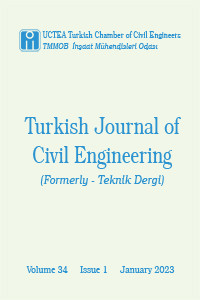Ani Bir Düşüdeki B-tipi Hidrolik Sıçramanın Sayısal Modellenmesi
Ani bir
düşü sonrasında oluşan B-tipi hidrolik sıçramanın özellikleri, farklı akım
koşulları için deneysel ve sayısal olarak incelenmiştir. Sonlu Hacimler
Yöntemine dayalı ANSYS-Fluent paket programı kullanılarak, akımı idare eden
denklemler Standart k-ε, Shear Stress
Transport ve Reynolds Stress türbülans modelleri ile sayısal olarak
çözülmüştür. Su yüzü profilinin hesabında Akışkan Hacimleri Yöntemi
kullanılmıştır. Hesaplama ağı yoğunluğunun sayısal bulgular üzerindeki hata
nispetini belirlemek amacıyla Ağ Yakınsama İndeksi yaklaşımı kullanılmıştır.
Sayısal hesaplamalardan elde edilen su yüzü ve hız profilleri, deneysel
ölçümlerle karşılaştırılmıştır. Ölçülen ve hesaplanan su yüzü ve hız
profillerindeki ortalama karesel hata ve ortalama mutlak göreli hata
ölçütlerine göre, Reynolds Stress modelinin, B-tipi hidrolik sıçrama profilinin
ve hız alanının belirlenmesinde, burada kullanılan diğer iki modelden daha
başarılı olduğu görülmüştür.
Anahtar Kelimeler:
: B-tipi hidrolik sıçrama, hız alanı, sayısal model, su yüzü profili, türbülans kapatma modeli
Numerical Modeling of B-Type Hydraulic Jump at an Abrupt Drop
The
properties of a B-type hydraulic jump at an abrupt drop are analyzed
experimentally and numerically for different flow cases. Using the Standard
k-ε, Shear Stress Transport and Reynolds Stress turbulence closure models, the
governing equations are solved numerically using ANSYS-Fluent program package
which is based on the Finite Volume Method. The Volume of Fluid (VOF) method is
used to determine the free surface profile. Grid independence study is carried
out using a Grid Convergence Index (GCI) analysis. The numerical results for
the free surface and velocity profiles of flow from the present turbulence
models are compared with experimental data. Mean square errors and mean
absolute relative errors of measured and predicted free surface profiles and
velocity fields indicate that Reynolds Stress Model is a more successful
turbulence closure model than the other two for the determination of surface
profile and velocity field of the B-type hydraulic jump.
Keywords:
B-type hydraulic jump, velocity field, free surface profile, numerical model, turbulence closure model,
___
- [1] Tokyay, N. D., Altan-Sakarya, A. B. ve Eski, E., Numerical simulation of minimum B-jumps at abrupt drops. International Journal for Numerical Methods in Fluids, 56(9), 1605–1623, 2008.
- [2] Tokyay, N. D. ve Ulubayram, H., Eşiklerde hidrolik sıçrama. IMO Teknik Dergi, 1990(1), 9-23, 1990.
- [3] Del Giudice, G., Gisonni, C. ve Rasulo, G., Design of a Scroll Vortex Inlet for Supercritical Approach Flow. Journal of Hydraulic Engineering, 136(10), 837–841, 2010.
- [4] Ram, K. V. S. ve Prasad, R., Spatial B-jump at sudden channel enlargements with abrupt drop. Journal of Hydraulic Engineering-ASCE, 124(6), 643–646, 1998.
- [5] Kawagoshi, N. ve Hager, W. H., B-Jump in Sloping Channel, II.. Journal of Hydraulic Research, 28(4), 461–480, 1990.
- [6] Gümüş, V., Şimşek, O., Soydan, N. G., Aköz, M. S. ve Kırkgöz, M. S., Tambur Kapak Mansabında Oluşan Batmış Hidrolik Sıçramanın Sayısal Analizi. International Construction Congress 2012, Isparta, 2012.
- [7] Gümüş, V., Aköz, M.S, Şimşek, O., Soydan, N. G. ve Kırkgöz, M.S., Experimental and Numerical Modeling of Free Hydraulic Jump Downstream of a Gate. 10th International Congress on Advances in Civil Engineering, Ankara, 2012.
- [8] Kırkgöz, M. S., Aköz, M. S. ve Öner, A. A., Numerical modeling of flow over a chute spillway. Journal of Hydraulic Research, 47(6),790–797, 2009.
- [9] Öner, A. A., Aköz, M. S., Kırkgöz, M. S. ve Gümüş, V., Experimental Validation of Volume of Fluid Method for a Sluice Gate Flow. Advances in Mechanical Engineering, 2012, 10, 2012.
- [10] Oertel, M. ve Bung, D. B., Initial stage of two-dimensional dam-break waves: laboratory versus VOF. Journal of Hydraulic Research, 50(1), 89–97, 2012.
- [11] Launder B. E. ve Spalding D., Lectures in Mathematical Models of Turbulence, London. Academic Press, 1972.
- [12] Menter, F. R., 2-Equation Eddy-Viscosity Turbulence Models for Engineering Applications. AIAA Journal, 32(8), 1598–1605, 1994.
- [13] Launder, B. E., Reece, G. J. ve Rodi, W., Progress in the development of a Reynolds-stress turbulence closure. Journal of Fluid Mechanics, 68(3), 537–566, 1975.
- [14] Wilcox, D.C., Turbulence Modeling for CFD, California. DCW Industries, Inc., 2000.
- [15] Hirt, C. W. ve Nichols, B. D., Volume of Fluid (Vof) Method for the Dynamics of Free Boundaries. Journal of Computational Physics, 39(1), 201–225, 1981.
- [16] Ansys Inc., Release 14.0. www.ansys.com, 2012.
- [17] Roache, P. J., Verification of codes and calculations. AIAA Journal, 36(5), 696 –702, 1998.
- [18] Kırkgöz, M.S. ve Ardıçlıoğlu, M., Velocity profiles of developing and developed open channel flow. Journal of Hydraulic Engineering, 123(12), 1099-1105, 1997.
- [19] Chen, H.C. ve Patel, V.C., Near-wall turbulence models for complex flows including separation. AIAA journal, 26(6), 641-648, 1988.
- [20] Versteeg, H.K. ve Malalasekera, W., An Introduction to Computational Fluid Dynamics: the finite volume method, England. Pearson Education, 2007.
- [21] Gümüş, V., Aköz, M. S., ve Kırkgöz, M. S., Kapak Mansabında Batmış Hidrolik Sıçramanın Deneysel ve Sayısal Modellenmesi. İMO Teknik Dergi ,24 (2), 6379-6397, 2013.
- ISSN: 2822-6836
- Yayın Aralığı: Yılda 6 Sayı
- Başlangıç: 1990
- Yayıncı: TMMOB İnşaat Mühendisleri Odası
Sayıdaki Diğer Makaleler
Betonarme Çerçevelerde Narinlik Etkisi
Günay ÖZMEN, Konuralp GİRGİN, Kutlu DARILMAZ
Betonarme Köprü Kolonlarında Plastik Mafsal Bölgelerinin Modellenmesi
Geosentetik Kil Örtülerin Hidrolik İletkenliklerinin Laboratuvarda Belirlenmesi Üzerine Bir Çalışma
Ali Hakan ÖREN, Havva DEMİRKIRAN
Ani Bir Düşüdeki B-tipi Hidrolik Sıçramanın Sayısal Modellenmesi
Oğuz ŞİMŞEK, N. Göksu SOYDAN, Veysel GÜMÜŞ, M. Sami AKÖZ, M. Salih KIRKGÖZ
